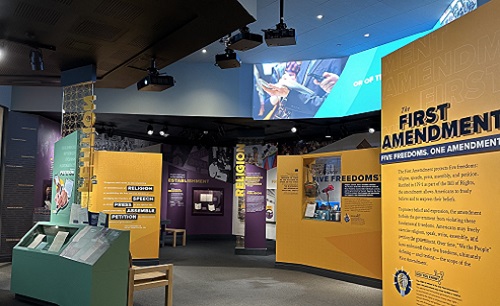This activity is part of Module 9: The Judicial System and Current Cases from the Constitution 101 Curriculum.
Article III, Section 1 begins with (what scholars refer to as) a vesting clause—vesting the “judicial power of the United States” in one Supreme Court and in whatever inferior courts Congress decides to establish.
- “The judicial Power of the United States, shall be vested in one supreme Court, and in such inferior Courts as the Congress may from time to time ordain and establish. The Judges, both of the supreme and inferior Courts, shall hold their Offices during good Behaviour, and shall, at stated Times, receive for their Services, a Compensation, which shall not be diminished during their Continuance in Office.”
In other words, Congress controls many of the key details of the national court system. This means that Congress has considerable authority to change the following:
- The size of the Supreme Court: The Supreme Court began at six justices. Over time, there’s been a low of five Justices and a high of 10 (during the Lincoln presidency). Congress has altered the size of the Supreme Court six times. The last time was in 1869. That’s how we got to the current number: nine justices.
- The Supreme Court’s docket: Congress sets the rules for how much control the Supreme Court has over the cases that it hears each year. For the modern Court, perhaps the most important move by Congress was its passage of the Judiciary Act of 1925. Chief Justice (and former President) William Howard Taft was the driving force behind (what we refer to today as) the “Judges Bill.” In many ways, Taft’s “Judges Bill” created the Supreme Court that we have today. Before 1925, the Court had limited control over the cases that it heard each year, and it had to hear a ton of cases each term. With the Judges Bill, Congress gave the Court broad control over the cases that it hears. That remains true today.
- The structure of the federal judiciary: Congress determines many of the details about the federal court system as a whole, including how many federal judges overall, how many courts of appeals, how many district courts, where they are located, how they are organized, and so forth.
Article III, Section 1, also tells us that federal judges—including Supreme Court justices—hold their offices for life (“during good behaviour”).
Generally speaking, there are no formal requirements in the Constitution for who may serve as a Supreme Court justice.
Article II, Section 2, sets out the appointment power.
Here’s the text of Article II, Section 2:
- The president “shall nominate, and by and with the Advice and Consent of the Senate, shall appoint . . . Judges of the supreme Court.”
- The president has the power to nominate someone to fill a Supreme Court seat.
- The Senate has the power to confirm or reject the person that the president chooses. To serve on the Supreme Court, a president’s nominee must receive the approval of the Senate.
But that’s all that the Constitution’s text says about the Supreme Court nomination process. The judicial nomination process today—the hearings, the questions, how qualified nominees must be, etc.—don’t come from the Constitution’s text. They’re a product of norms created over time and the actions of Congress.
Generally speaking, here are the steps in that process today:
- A seat on the Supreme Court opens up. (So, a justice retires or dies.)
- The president considers a number of potential people for the position—reading about them, asking for advice from others (advisors, members of Congress, scholars, political leaders, interest groups, etc.), interviewing potential choices, and so forth.
- The president selects someone.
- That person accepts the nomination.
- The Senate Judiciary Committee—the Senate group in charge of the Supreme Court nomination process—holds confirmation hearings: The president’s nominee shows up at the Senate. The senators ask their questions like in a job interview, trying to understand the nominee’s judicial philosophy and experience. The nominee answers them.
- The Committee votes on whether to recommend confirmation to the rest of the Senate.
- If they vote “yes,” then the nomination is sent to the full Senate.
- If they vote “no,” then the whole process starts all over again.
- The full Senate debates the nominee and votes on her confirmation.
- If she wins Senate approval, she then becomes a Supreme Court justice.
- If not, then the whole process starts all over again.
Of course, there are exceptions to this general process, but this is how it usually works.






